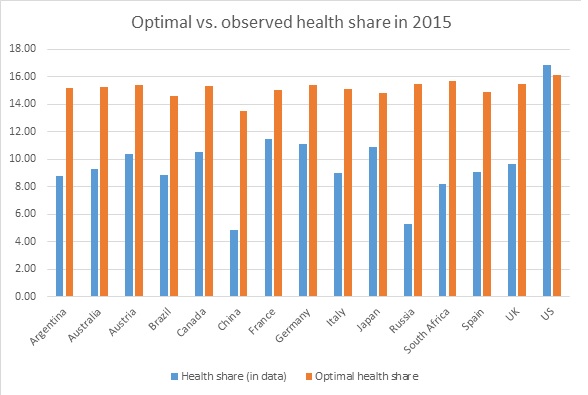
Measured in terms of economic welfare, including consumption and life expectancy, the share of health care expenditures in most developed economies is too low.
For many years public debate has been dominated by the concern that the share of health care of Western economies is too high and too expensive, thus inhibiting economic growth. This has frequently resulted in a call for “cost containment” to increase the efficiency of the health care sector. In our study recently published in Social Science and Medicine, my colleagues and I argue that the question of health care efficiency has to be dealt with in a more differentiated way. While there is a potential for cost reductions in several areas of the health care sector, this does not mean that, from an overall economic perspective, fewer resources should be invested into health care. In other words, a more efficient utilization of resources does not mean that the overall amount of health care expenses should be reduced.
We substantiate our argument by applying a model developed by Hall and Jones to a series of developed or developing economies (see Figure 1 below). We found that the scope of a country’s health care system could be measured in terms of the health share, that is, the share of health care expenditures in relation to a country’s gross domestic product (GDP).
The optimal health share is then derived on the basis of a comparison of the increase in welfare, or wellbeing, that would result from an increased life expectancy as a consequence of additional health care expenditures with the increase in welfare that would result from investing those additional health care expenses into consumption. Our model calculations are based on a “health production function” of life expectancy that was estimated from World Bank data and a utility function, as is typically applied in the economic literature.
It has been shown that for most countries, a health share of over 15% is optimal. This is a value that, with the exception of the United States, lies more or less clearly above the currently observed shares of health care expenditures in GDP as illustrated below.
 © Chen et al. (2021)
© Chen et al. (2021)
Figure 1 (Source: Authors’ own calculations based on World Bank data).
In most high-income economies, high health care expenditures can be justified by the fact that in societies that experience very high levels of material consumption, for large parts of the population the benefit arising from additional consumption is considerably lower than the benefit arising from additional lifetime, especially if that additional time is accompanied by a relatively high living standard. From a welfare-economic perspective, it is clear that in most countries there is still considerable potential for growth in the health care sector.
References
Chen, S., Kuhn, M., Prettner, K., Bloom, D. E., & Wang, C. (2021). Macro-level efficiency of health expenditure: Estimates for 15 major economies. Social Science & Medicine, 287, 114270. https://doi.org/10.1016/j.socscimed.2021.114270
Hall, R. E., & Jones, C. I. (2007). The value of life and the rise in health spending. The Quarterly Journal of Economics, 122(1), 39-72.
Note: This article gives the views of the author, and not the position of the Nexus blog, nor of the International Institute for Applied Systems Analysis.